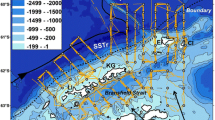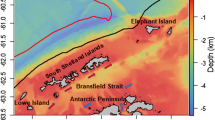Abstract
Fin whale (Balaenoptera physalus quoyi) habitat use and its relationship to environmental conditions are generally unknown in the Southern Ocean, presenting challenges for predicting their seasonal occurrence and potential effects of fishing pressure and climate change on this endangered species. Using biological data collected during 14 shipboard surveys off the northern Antarctic Peninsula and oceanographic data from satellite remote sensing, we mapped the distribution of fin whale hotspots, Antarctic krill abundance (biomass from acoustics, concentrations from nets) and ocean conditions during mid- and late-summer to investigate the environmental determinants of whale hotspots. Generalized additive models (GAM) were used to test the hypothesis that intra-seasonal changes in fin whale hotspot distribution relate to sea surface temperature (SST), krill abundance and eddy kinetic energy (EKE). More whale hotspots (sightings and individuals) are observed during late- than mid-summer surveys. During mid-summer, hotspots occurred near Elephant Island while in late-summer they were distributed throughout the slope region in proximity to the mean location of the southern Antarctic Circumpolar Current Front. The spatial mean of EKE did not differ between mid- and late-summer surveys, but the spatial mean of SST was significantly warmer during late-summer. The GAM for mid-summer indicates that fin whale hotspots were positively related to SST, EKE and acoustically determined krill biomass. The GAM for late-summer indicates the hotspots were negatively related to net-based krill abundance and positively related to acoustic krill biomass and EKE. This study is important because environmental determinants of fin whale hotspots may be used as reference points for implementing future conservation plans for their recovering populations.






Similar content being viewed by others
References
Amos A (2001) A decade of oceanographic variability in summertime near Elephant Island, Antarctica. J Geophys Res 106:22401–22423. doi:10.1029/2000JC000315
Atkinson A, Siegel V, Pakhomov EA, Rothery P, Loeb V, Ross RM, Quetin LB, Schmidt K, Fretwell P, Murphy EJ, Tarling GA, Fleming AH (2008) Oceanic circumpolar habitats of Antarctic krill. Mar Ecol Prog Ser 362:1–23
Bailey H, Mate BR, Palacios DM, Irvine L, Bograd SJ, Costa DP (2010) Behavioral estimation of blue whale movements in the Northeast Pacific from state-space model analysis of satellite tracks. Endanger Species Res 10:93–106
Ballance L, Pitman RL, Hewitt RP, Siniff DB, Trivelpiece WZ, Clapman PJ, Brownell RL Jr (2006) The removal of large whales from the Southern Ocean: evidence for long-term ecosystem effect? In: Estes JA, DeMaster DP, Doak DF, Williams TE, Brownell RL Jr (eds) Whales, whaling and ocean ecosystems. University of California Press, Berkeley, pp 130–215
Barré N, Provost C, Renault A, Sennechael N (2011) Fronts, meanders and eddies in Drake Passage during the ANT-XXIII/3 cruise in January–February 2006: a satellite perspective. Deep-Sea Res II 58:2533–2554
Bost CA, Cotté C, Bailleul F, Cherel Y et al (2009) The importance of oceanographic fronts to marine birds and mammals of the southern oceans. J Mar Res 78:363–376
Buckland ST, Anderson DR, Burnham KP, Laake JL (1993) Distance sampling: estimating abundance of biological populations. Chapman & Hall, London
Ferrari R, Provost C, Sennéchael N, Lee JH (2013) Circulation in Drake Passage revisited using new current time series and satellite altimetry: 2. The Ona Basin. J Geophys Res-Oceans 118:147–165
Friedlaender AS, Halpin PN, Qian SS, Lawson GL, Wiebe PH, Thiele D, Read AJ (2006) Whale distribution in relation to prey abundance and oceanographic processes in shelf waters of the Western Antarctic Peninsula. Mar Ecol Prog Ser 317:297–310
Hewitt RP, Demer DA, Emery JH (2003) An 8-year cycle in krill biomass density inferred from acoustic surveys conducted in the vicinity of the South Shetland Islands during the austral summers of 1991–1992 through 2001–2002. Aquat Living Resour 16:205–213
Hewitt RP, Watters G, Trathan PN, Croxall JP et al (2004) Options for allocating the precautionary catch limit of krill among small-scale management units in the Scotia Sea. CCAMLR Sci 11:81–97
Hooker SK, Gerber LR (2004) Marine reserves as a tool for ecosystem-based management: the potential importance of megafauna. Bioscience 54:27–39
Johnston DW, Thorne LH, Read AJ (2005) Fin whales Balaenoptera physalus and minke whales Balaenoptera acutorostrata exploit a tidally driven island wake ecosystem in the Bay of Fundy. Mar Ecol Prog Ser 305:287–295
Jones CD, Ramm DC (2004) The commercial harvest of krill in the southwest Atlantic before and during the CCAMLR 2000 Survey. Deep-Sea Res II 51:1421–1434
Kahru M, Mitchell BG, Gille ST, Hewes CD, Hom-Hansen O (2007) Eddies enhance biological production in the Weddell-Scotia confluence of the Southern Ocean. Geophys Res Lett 34:L14603. doi:10.1029/2007GL030430
Kawaguchi S, Nicol S, Takio K, Naganobu M (2006) Fishing ground selection in the Antarctic krill fishery: trends in patterns across years, seasons and nations. CCAMLR Sci 13:117–141
Lascara CM, Hofmann EE, Ross RM, Quetin LB (1999) Seasonal variability in the distribution of Antarctic krill (Euphausia superba) west of the Antarctic Peninsula. Deep Sea Res I 46:951–984
Laws RM (1977) Seals and whales of the Southern Ocean. Philos Trans R Soc Lond B 279:81–96
Leaper R, Miller C (2011) Management of Antarctic baleen whales amid past exploitation, current threats and complex marine ecosystems. Antarct Sci 23:503–529
Lenn Y-D, Chereskin TK, Sprintall J, Firing E (2007) Mean jets, mesoscale variability and eddy momentum fluxes in the surface layer of the Antarctic Circumpolar Current in Drake Passage. J Mar Res 65:27–58
Loeb VJ, Santora JA (2012) Population dynamics of Salpa thompsoni near the Antarctic Peninsula: growth rates and interannual variations in reproductive activity (1993–2009). Prog Oceanogr 96:93–107
Loeb VJ, Santora JA (2013) Pteropods and climate off the Antarctic Peninsula. Prog Oceanogr 116:31–48
Loeb VJ, Hofmann EE, Klinck JM, Holm-Hansen O, White WB (2009) ENSO and variability of the Antarctic Peninsula marine ecosystem. Antarct Sci 21:135–148
Loeb VJ, Hofmann EE, Klinck JM, Holm-Hansen O (2010) Hydrographic control of the marine ecosystem in the South Shetland-Elephant Island and Bransfield Strait region. Deep-Sea Res II 57:519–542
Mackintosh A (1965) The stocks of whales. Fishing News (Books) Ltd, London
MacLeod CD (2009) Global climate change, range changes and potential implications for the conservation of marine cetaceans: a review and synthesis. Endanger Species Res 7:125–136
Meredith MP, Hogg AM (2006) Circumpolar response of Southern Ocean eddy activity to a change in the Southern Annular Mode. Geophy Res Lett 33:L16608. doi:10.1029/2006GL026499
Meredith MP, King JC (2005) Rapid climate change in the ocean west of the Antarctic Peninsula during the second half of the 20th century. Geophys Res Lett 32:L19604. doi:10.1029/2005GL024042
Murase H, Kitakado T, Hakamada T, Matsuoka K, Nishiwaki S, Naganobu M (2013) Spatial distribution of Antarctic minke whales (Balaenoptera banaerensis) in relation to spatial distributions of krill in the Ross Sea, Antarctica. Fish Oceangr 22:154–173
Nicol S, De La Mare WK, Stolp M (1995) The energetic cost of egg production in Antarctic krill (Euphausia superba Dana). Antarct Sci 7:25–30
Nicol S, Foster J, Kawaguchi S (2012) The fishery for Antarctic krill–recent developments. Fish Fish 13:30–40
Orsi AH, Whitworth T, Nowlin WD (1995) On the meridional extent and fronts of the Antarctic Circumpolar Current. Deep-Sea Res I 42:641–673
Pollard RT, Lucas ML, Read JF (2002) Physical controls on biogeochemical zonation in the Southern Ocean. Deep-Sea Res II 49:3289–3305
R Development Core Team (2014) R: A language and environment for statistical computing (mgcv package version 1.7-29). R Foundation for Statistical Computing, Vienna, Austria
Reid K, Brierly AS, Nevitt GA (2000) An initial examination of relationships between the distribution of whales and Antarctic krill, Euphausia superba at South Georgia. J Cetacean Res Manag 2:143–149
Reilly S, Hedly S, Borberg J, Hewitt R, Thiele D, Watkins J, Naganobu M (2004) Biomass and energy transfer to baleen whales in the South Atlantic sector of the Southern Ocean. Deep-Sea Res II 51:1397–1409
Reilly SB, Bannister JL, Best PB, Brown M, Brownell Jr. RL, Butterworth DS, Clapham PJ, Cooke J, Donovan GP, Urbán J, Zerbini AN (2013) Balaenoptera physalus. In: IUCN 2013. IUCN red list of threatened species. Version 2013.1. www.iucnredlist.org. Downloaded on 31 Oct 2013
Reiss CS, Cossio AM, Loeb V, Demer DA (2008) Variations in the biomass of Antarctic krill (Euphausia superba) around the South Shetland Islands, 1996–2006. ICES J Mar Sci 65:497–508
Santora JA (2012) Habitat use of hourglass dolphins near the South Shetland Islands, Antarctica. Polar Biol 35:801–806
Santora JA (2013) Dynamic intra-seasonal habitat use of Antarctic fur seals suggests migratory hotspots near the Antarctic Peninsula. Mar Biol 160:1383–1393
Santora JA, Veit RR (2013) Spatio-temporal persistence of top predator hotspots near the Antarctic Peninsula. Mar Ecol Prog Ser 487:287–304
Santora JA, Reiss CS, Cossio AM, Veit RR (2009) Interannual spatial variability of krill influences seabird foraging behavior near Elephant Island, Antarctica. Fish Oceanogr 18:20–35
Santora JA, Reiss CS, Loeb VJ, Veit RR (2010) Spatial association between hotspots of baleen whales and demographic patterns of Antarctic krill Euphausia superba suggest size dependent predation. Mar Ecol Prog Ser 405:255–269
Santora JA, Sydeman WJ, Schroeder ID, Reiss CS et al (2012) Krill space: a comparative assessment of mesoscale structuring in polar and temperate marine ecosystems. ICES J Mar Sci 69:1317–1327
Siegel V (1988) A concept of seasonal variation of krill (Euphausia superba) distribution and abundance west of the Antarctic Peninsula. In: Sarhage D (ed) Antarctic Ocean and resources variability. Springer, Berlin
Siegel V (2005) Distribution and population dynamics of Euphausia superba: summary of recent findings. Polar Biol 29:1–22
Sokolov S, Rintoul SR (2009a) Circumpolar structure and distribution of the Antarctic Circumpolar Current fronts: 1. Mean circumpolar paths. J Geophys Res 114:C11018. doi:10.1029/2008JC005108
Sokolov S, Rintoul SR (2009b) Circumpolar structure and distribution of the Antarctic Circumpolar Current fronts: 2. Variability and relationship to sea surface height. J Geophys Res 114:C11019. doi:10.1029/2008JC005248
Sprintall J (2003) Seasonal to interannual upper-ocean variability in the Drake Passage. J Mar Res 61:27–57
Sudre J, Maes C, Garçon V (2013) On the global estimates of geostrophic and Ekman surface currents. Limnol Oceanogr Fluids Environ 3:1–20
Tarling GA, Klevjer T, Fielding S, Watkins J, Atkinson A, Murphy E, Korb R, Whitehouse M, Leaper R (2009) Variability and predictability of Antarctic krill swarm structure. Deep Sea Res I 56:1994–2012
Thompson AF, Heywood KJ, Thorpe SE, Renner AHH, Trasvina A (2009) Surface circulation at the tip of the Antarctic Peninsula from drifters. J Phys Oceanogr 39:3–26
Tin T, Fleming ZL, Hughes KA, Ainley DG et al (2008) Impacts of local human activities on the Antarctic environment. Antarct Sci 21:3–33
Tynan CT (1998) Ecological importance of the southern boundary of the Antarctic Circumpolar Current. Nature 392:708–710
Venables H, Meredith M, Atkinson A, Ward P (2012) Fronts and habitat zones in the Scotia Sea. Deep-Sea Res II 59–60:14–24
Watters GM, Hill SL, Hinke JT, Matthews J, Reid K (2013) Decision-making for ecosystem-based management: evaluating options for a krill fishery with an ecosystem dynamics model. Ecol Appl 23:710–725
Wood SN (2006) Generalized additive models: an introduction with R. Taylor and Francis, Boca Raton
Zuur AF, Ieno EN, Walker NJ, Saveliev AA, Smith GM (2009) Mixed effects models and extensions in ecology with R. Springer, New York
Acknowledgments
We thank the previous participants of the NOAA-NMFS U.S. AMLR field season team for their dedication and assistance at sea. Special thanks to M. P. Force for assistance with visual surveys and to C. S. Reiss, A. Cossio and G. Watters for maintaining the shipboard survey and providing acoustic krill data. We are grateful for the constructive feedback by two anonymous reviewers, which greatly improved this paper. The field portion study was funded in part by the U.S. AMLR program, NSF OPP awards 9983751, 0337648 to R. R. Veit and the synthesis was supported by NSF OPP award 1347911.
Author information
Authors and Affiliations
Corresponding author
Additional information
Communicated by A. Atkinson.
Rights and permissions
About this article
Cite this article
Santora, J.A., Schroeder, I.D. & Loeb, V.J. Spatial assessment of fin whale hotspots and their association with krill within an important Antarctic feeding and fishing ground. Mar Biol 161, 2293–2305 (2014). https://doi.org/10.1007/s00227-014-2506-7
Received:
Accepted:
Published:
Issue Date:
DOI: https://doi.org/10.1007/s00227-014-2506-7




